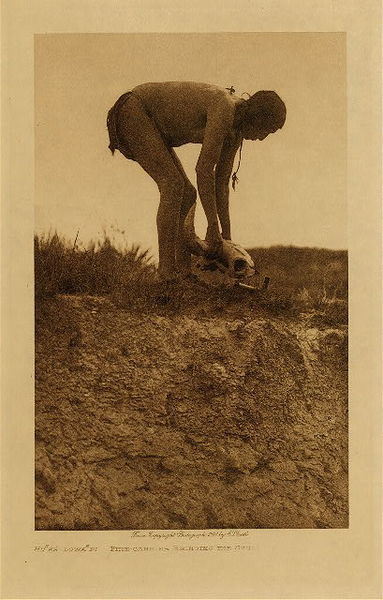Edward S. Curtis (1868-1952)
View Artist Biography
Title:
*50% OFF OPPORTUNITY* Huka-Lowapi - Fire-carrier Bringing the Skull
Date:
1908
Size:
Volume, 12.5 x 9.5 inches
Medium:
Vintage Photogravure
This Edward Curtis photograph is depicting a part of a ceremony called Huka-lowapi. The name of the Huka-lowapi ceremony is taken from Huka a term of respect for ones parents or ancestors, and Lowapi, they chant. The purpose of the ceremony is to implant the virtues of kindness, generosity, hospitality, truthfulness, fairness, and honesty. At the same time it is a prayer for continued prosperity, abundance of food, health, strength, and moral well-being as people.
"Work-do now appoints the Fire-carrier, giving him the two fire-sticks— peeled cherry rods about eighteen inches long, split at one end to form a prong— and with his knife shaves the grass from a small circular spot. The Firecarrier, at his bidding, brings a burning coal on the end of one of his forked sticks, which he deposits with the end inside the circular spot, exercising the greatest care; for to drop the coal would portend the death of himself or one of his family.
The Fire-carrier is sent for a whitened buffalo-skull with the horns still attached, and a quantity of sage, both of which are brought and left a short distance from the tipi. This ends the preparations for the actual ceremony." -Edward S. Curtis in "The North American Indian"
The photogravure was taken in 1908 by Edward Curtis and is printed on Japon Vellum. The piece is available for sale in our Aspen Art Gallery.
Provenance:
Art Institute of Chicago, Ryerson & Burnham Library
"Work-do now appoints the Fire-carrier, giving him the two fire-sticks— peeled cherry rods about eighteen inches long, split at one end to form a prong— and with his knife shaves the grass from a small circular spot. The Firecarrier, at his bidding, brings a burning coal on the end of one of his forked sticks, which he deposits with the end inside the circular spot, exercising the greatest care; for to drop the coal would portend the death of himself or one of his family.
The Fire-carrier is sent for a whitened buffalo-skull with the horns still attached, and a quantity of sage, both of which are brought and left a short distance from the tipi. This ends the preparations for the actual ceremony." -Edward S. Curtis in "The North American Indian"
The photogravure was taken in 1908 by Edward Curtis and is printed on Japon Vellum. The piece is available for sale in our Aspen Art Gallery.
Provenance:
Art Institute of Chicago, Ryerson & Burnham Library
